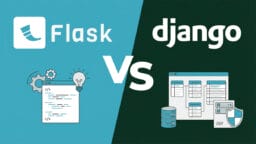When it comes to machine learning applications, operational and training phases for algorithms are quite different. Most of the companies prefer different languages for different phases. The overall idea behind this objective is to do some experiment in the development phase and figure out language that can be best suited.
Machine learning was rated as one of the highly admired skills in the last couple of years. Today, more than 80% of the developers focus on acquiring this skill and they mostly prefer Python programming language for this purpose. The research also demonstrated that over 57% of the data scientists consider Python and other languages are not even near to it in terms of popularity. When it comes to user following, it has even beat C# and shown tremendous growth in several machine learning applications. It has won hearts of developers that belong to all the ages and abilities.
Why Python?

There are several common and uncommon reasons behind choosing Python programming language over other languages and you need to get into every single detail to understand it. Here we have listed all the important reasons that persuade data scientists to prefer Python programming language for machine learning:
Recommended for you: Introduction to Programming: A Brief of Node JS, Laravel, React, Ruby, Vue & Python.
1. The Simplicity:
 Python is always recognized as a language of beginners and even a programmer with basic knowledge can easily work with it. Developers don’t face any engineering constraints while using it and they don’t need to worry about time lost in dubbing codes. The overall time consumed in Python is quite less when compared with other languages such as Java, C, C++. On the virtue of this advantage, developers can use their saved time on algorithms and they can more focus on heuristics related with ML and AI. If you are planning to develop your application from a very ground level then it is recommended to use Python as your most preferred programming language.
Python is always recognized as a language of beginners and even a programmer with basic knowledge can easily work with it. Developers don’t face any engineering constraints while using it and they don’t need to worry about time lost in dubbing codes. The overall time consumed in Python is quite less when compared with other languages such as Java, C, C++. On the virtue of this advantage, developers can use their saved time on algorithms and they can more focus on heuristics related with ML and AI. If you are planning to develop your application from a very ground level then it is recommended to use Python as your most preferred programming language.
2. The Flexibility:
 Most of the data scientists opt for Python as it is perfectly suited for vital tasks such as data mining and sentiment analysis. There is also no surprise that Python is also admired among top programmers who are known for their high expertise and experience. App developers also find Python quite convenient to use as it can be easily adaptable to the specific tasks on hand. Python is also considered a highly flexible and precise alternative when compared with other programming languages. No wonder developers of some of the reputed social networking platforms such as Pinterest and Instagram have used Python to transfer their vision into reality.
Most of the data scientists opt for Python as it is perfectly suited for vital tasks such as data mining and sentiment analysis. There is also no surprise that Python is also admired among top programmers who are known for their high expertise and experience. App developers also find Python quite convenient to use as it can be easily adaptable to the specific tasks on hand. Python is also considered a highly flexible and precise alternative when compared with other programming languages. No wonder developers of some of the reputed social networking platforms such as Pinterest and Instagram have used Python to transfer their vision into reality.
As Larry Dignan, the Editor-in-Chief of ZDNet, summarized in one of his interviews,
“Python is recognized as a general-purpose programming language which can easily be suited to a wide range of machine learning activities. It is widely popular among data analysts as it can effortlessly compute data from NoSQL and some other advanced databases.”

3. Backgrounds & Available Libraries:
 An application area and type of project is another decisive factor when choosing a particular language for machine learning. Developers prefer Python for the projects which are low enterprise focused like NLP. It lets them create a quick and convenient way to develop perform oriented algorithms. Most of the data scientists also prefer it because a huge collection of dedicated libraries that comes along with the Python.
An application area and type of project is another decisive factor when choosing a particular language for machine learning. Developers prefer Python for the projects which are low enterprise focused like NLP. It lets them create a quick and convenient way to develop perform oriented algorithms. Most of the data scientists also prefer it because a huge collection of dedicated libraries that comes along with the Python.
Professional background is another key factor while prioritizing the programming language. Python has become a vital part of data visualization and professionals who are studying data science as a part of their university training usually prefer Python over others. In recent time, it has also evolved into different native languages that data scientists can easily understand.
4. Availability of a vast AI-focused Libraries:
 Python offers an extensive number of specialized libraries for artificial intelligence and machine learning. Scikit-learn, Seaborn, Matplotlib, TensorFlow and Pytorch are some of the examples of inbuilt libraries which can be used for data visualization, data analysis, and data mining. There are also wide ranges of data science tutorials available where libraries of Python are utilized. You can search for these tutorials online to understand the applications of Python libraries in more detail.
Python offers an extensive number of specialized libraries for artificial intelligence and machine learning. Scikit-learn, Seaborn, Matplotlib, TensorFlow and Pytorch are some of the examples of inbuilt libraries which can be used for data visualization, data analysis, and data mining. There are also wide ranges of data science tutorials available where libraries of Python are utilized. You can search for these tutorials online to understand the applications of Python libraries in more detail.
5. Ease of Use & Compatibility:
 Ease of use is another key reason why Python is preferred by several research and data scientist communities. It has got a simple syntax that makes it more convenient for users who don’t belong to the engineering background. Python is very appropriate for quick prototyping and this is another reason why data science online courses push their students to choose Python over other languages.
Ease of use is another key reason why Python is preferred by several research and data scientist communities. It has got a simple syntax that makes it more convenient for users who don’t belong to the engineering background. Python is very appropriate for quick prototyping and this is another reason why data science online courses push their students to choose Python over other languages.
The ability of Python to employ modular components makes it highly compatible with other programming languages. It is tremendously powerful and adaptable with a wide range of technologies. It has also got amazing component integrity and you can easily import other languages to use them with Python.

6. Human Resource:
 In current time, when big companies look for analytics and data science professionals, expertise in Python is one of the most vital skills they search for in professionals. This is an obvious reason why most of the emerging engineers and developers prefer to acquire proficiency in Python and learn such a language which is in high demand.
In current time, when big companies look for analytics and data science professionals, expertise in Python is one of the most vital skills they search for in professionals. This is an obvious reason why most of the emerging engineers and developers prefer to acquire proficiency in Python and learn such a language which is in high demand.
As Piotr Majchrzak, the Co-CEO at Boldare, explained the mindset of the programmers in one of his conferences,
“Nowadays, programmers are extremely cautious about their choices and they do a lot of research before choosing a specific programming language. For example, Java is mostly selected when it comes to developing algorithms for fraud detection and network security. However, Python is highly preferred language when it comes to sentimental analysis and Natural Language Processing (NLP).”
7. Productivity:
 According to recent research, there has been significant evolution witnessed in the field of Python frameworks in the last few years thereby making it extremely productive in long term. On the virtue of its versatility, most of the programmers have also started using it for the multitasking purpose in the field of data science.
According to recent research, there has been significant evolution witnessed in the field of Python frameworks in the last few years thereby making it extremely productive in long term. On the virtue of its versatility, most of the programmers have also started using it for the multitasking purpose in the field of data science.
Data scientists who are coming from diverse backgrounds find Python much convenient. Its inherent ease and readability make it easy to understand relative to other programming languages. Besides this, availability of multiple analytical libraries means data scientists in each sector easily get packages which are tailored to their specific needs and they can be quickly downloaded free of charge.
8. Multi-Paradigm:
 When it comes to coding, Python is considered as a multi-paradigm language for programmers. It easily supports structural programming, object-oriented programming (OOP) along with functional programming patterns. Whether it is website development, data mining or simply running embedded systems, Python can manage all the tasks quite easily.
When it comes to coding, Python is considered as a multi-paradigm language for programmers. It easily supports structural programming, object-oriented programming (OOP) along with functional programming patterns. Whether it is website development, data mining or simply running embedded systems, Python can manage all the tasks quite easily.
As Python is designed in such a way to have a lightweight core, the dedicated libraries can be built in it with specialized tools for different kinds of programming tasks. The ease in usability also allows data scientists to quickly go to the center of the problem without any need for supervising complicated functions within the libraries.

9. Open Source & Cost Effectiveness:
 Being a truly versatile software, Python can be used for free and any programmer can write a specialized library package to enhance its main functionality. Out of the entire crowd, data scientists are the ones who are an early beneficiary of such customized extensions. For instance, data analysis libraries such as Pandas can be employed for importing vital data from excel and professing multiple sets for analysis. It has directly kept an important tool of data munching at the fingertips of developers. It eventually allowed you to conduct basis cleanup along with highly advanced manipulation using potent data-frames of Pandas.
Being a truly versatile software, Python can be used for free and any programmer can write a specialized library package to enhance its main functionality. Out of the entire crowd, data scientists are the ones who are an early beneficiary of such customized extensions. For instance, data analysis libraries such as Pandas can be employed for importing vital data from excel and professing multiple sets for analysis. It has directly kept an important tool of data munching at the fingertips of developers. It eventually allowed you to conduct basis cleanup along with highly advanced manipulation using potent data-frames of Pandas.
Offering an open source platform is another valid reason behind the rising popularity of Python amongst data scientists. Having such a large base means there are millions of individuals who are keen to provide you with crucial advice when you face any issues related to this language. There is always a chance that someone has already stuck with similar kind of problem and he is happy to share his experience so you don’t need to waste your time doing trial and errors. This platform is highly beneficial for newcomers who really can’t waste with their resources. They can figure out solutions quite efficiently.
You may also like: Programming Tips: How to Learn to Code on a Budget.
10. Python Community:
 There are several dedicated groups and communities spread all over the world which are contributing one or other way towards the field of data science. Python is so prevalent amongst these data science communities that you will always find out the right resources that will match your requirement.
There are several dedicated groups and communities spread all over the world which are contributing one or other way towards the field of data science. Python is so prevalent amongst these data science communities that you will always find out the right resources that will match your requirement.
The Bottom Line:

All in all, Python has a tremendous potential to offer a lot to emerging machine learning programmers who are still in learning phase. A recently conducted survey has revealed that Python has seen a drastic increase in usage for the last few years. Experts have also alleged that Python will remain the most sought-after programming language in the next few years as well. Courtesy to the wide range of advantages of Python, in the coming time programmers may find it adaptable to be used in the data analytics field. Though it is not completely suited for statistical analysis, companies who have done a chunk of investment may try to experiment and use it for such an important purpose.
However, popularity should not be the only parameter while selecting a specific programming language for machine learning. There is no such thing called ‘ideal language for machine learning’. It all comes down to your background, why you get into the machine learning and what you want to build.






